These Charts Are Everything You Need to Choose Furniture
Buzzfeed's DIY editor breaks down how to identify your decorating style and incorporate it into your space, with tips from the book Home Decor Cheat Sheets
By Jessica Probus
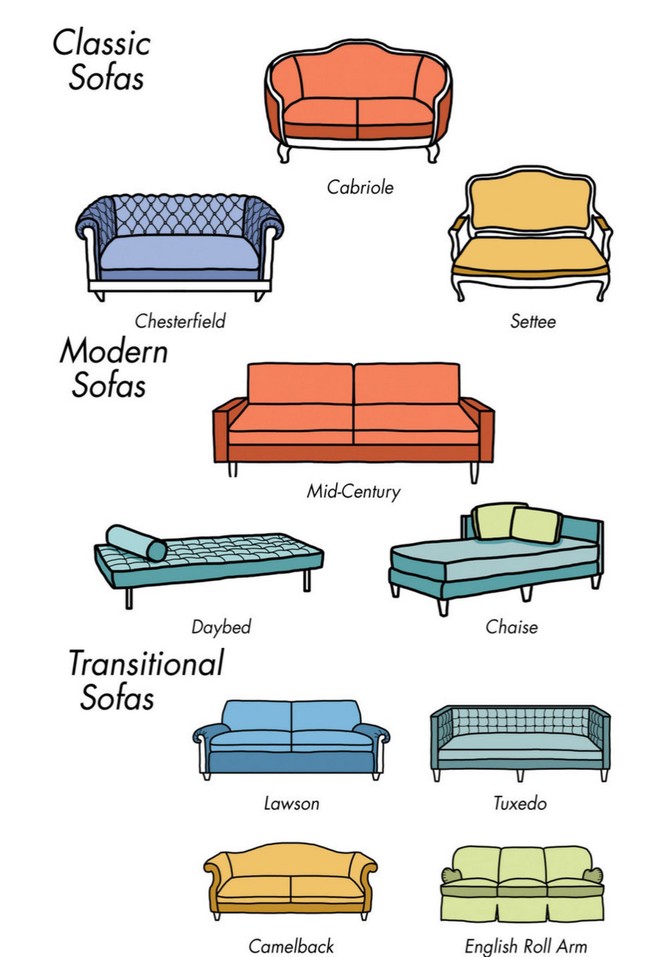
Illustration: Alice Mongkongllite
How to Choose a Sofa
Choosing a sofa is a big decision, not only because of the cost, but also because they set the tone for the style of the room. While all furniture designers and manufacturers have their own unique names for their sofa models, these are 10 of the most common silhouettes and names for sofa styles, ranging from a more traditional Old World look to a sleek, modern shape.
Sofa glossary
Bench Seat: A single cushion that goes the entire length of the sofa.
Camelback: A common type sofa which has a back that’s highest in the middle, shaped like a camel’s hump.
Deck: The bottom structure of the sofa where the seat cushions rest. In loose-cushion models, the deck is usually upholstered in a neutral-colored fabric instead of the upholstery material.
Left-Arm or Right-Arm: Used to describe which side a chaise is located on a sectional when you are facing the sofa.
Loose Cushion: A sofa which has cushions that are not attached to the sofa base. These tend to be very comfortable and easier to clean. Some models can have a pillow back with tight seat cushions, some have a tight back with loose seat cushions.
Pillow Back: Another term for loose-cushion models where the cushions are not attached to the deck.
Rolled Arm: A sofa style with arms that curve outward, usually cushioned. This is a classic and traditional sofa style.
Sectional: A sofa that comes in multiple parts that can often be rearranged to make a new shape. The most common is the L-shaped sectional.
Skirt: A section of fabric that extends from the deck of the sofa to the floor, usually covering the legs.
Sleeper: Any sofa that can be adjusted to become a bed, whether it’s a pull-out model or a futon style that leans back.
Square Arm: A sofa style with arms that are boxy and usually cushioned. These models are more streamlined and modern.
Tight Back: A sofa with no removable cushions. This minimalist look tends to be less comfortable than loose-cushion models. Instead of a filled cushion, these usually have a spring base.
Tufted: An upholstery style that uses knots or buttons to secure sections of the fabric to the base, resulting in “tufts” of fabric. Tufted sofas have a classic and expensive look but are often less comfortable than other models.
Welt: A decorative cord used as an accent along the lines of an upholstered piece, sometimes used in a contrasting color from the upholstery.
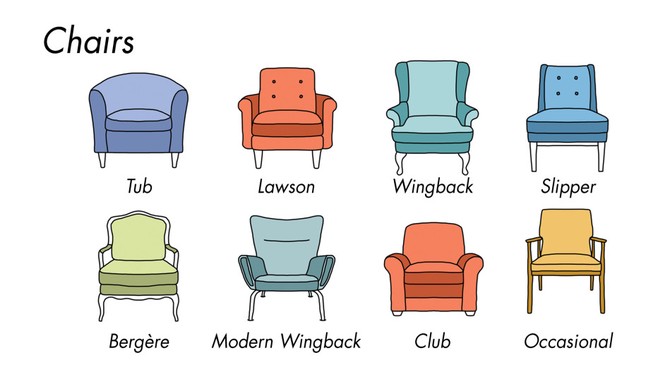
Illustration: Alice Mongkongllite
How to Choose Upholstered Chairs
Upholstered accent chairs are a great way to add extra seating to a space and mix different design styles in one room. A bigger investment, armchairs are more comfortable than occasional chairs, which are smaller and more portable, meeting whatever seating needs arise on any occasion.
Pro Tip: If your sofa and chairs are dramatically different in style, use throw pillows in matching colors or coordinating patterns to tie the space together.
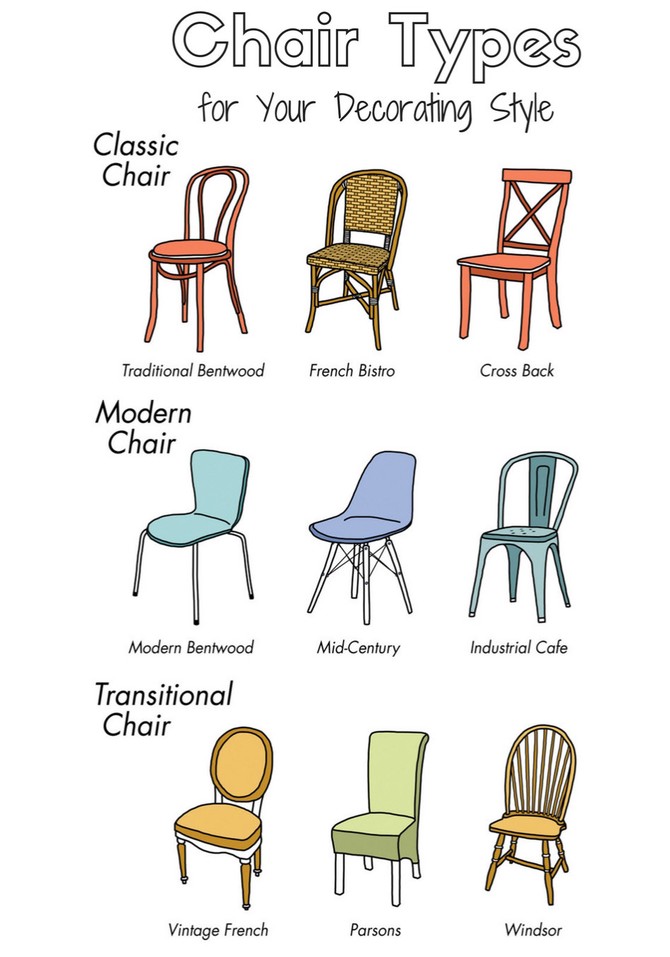
Illustration: Alice Mongkongllite
How to Choose Dining Chairs
The right dining chairs can totally change the look of a table. And if you’re feeling brave, mixing and matching a set of dining chairs is a great way to add character to an older dining table without having to buy a whole new set. To make a group of mismatched chairs feel unified, paint them all the same color or use matching upholstery for the cushions.
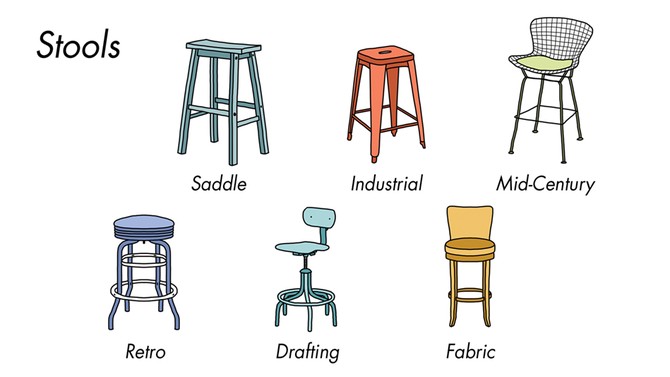
Illustration: Alice Mongkongllite
How to Choose the Right Kind of Stool
The kind of stool you choose should depend on the style of your room and how often you plan to use it. Backless stools take up less visual space but are much less comfortable for everyday use. Upholstered or high-back stools are often more expensive and take up more space, but are much more comfortable as actual dining chairs. While classic stools tend to be high-backed and modern or industrial low and un-cushioned, there are a wide range of stool shapes in every style.
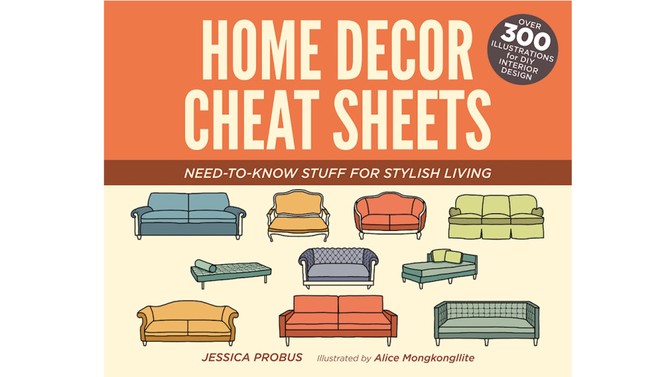
Reprinted from Home Decor Cheat Sheets: Need-to-Know Stuff for Stylish Living by Jessica Probus and Alice Mongkongllite. Text copyright © 2016 by Jessica Probus. Illustrations copyright © 2016 by Alice Mongkongllite. Design and concept copyright © 2016 Ulysses Press and its licensors. Published by Ulysses Press.
Published 10/09/2016

